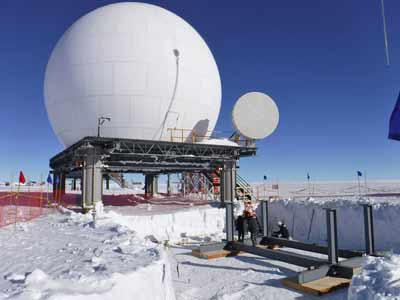 Perhaps one of the most visible projects of the season...a new shelter for electronic satcom equipment (SH). |
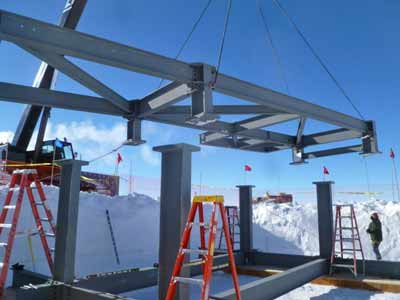 The next section of the support frame is being lifted into place, in early December (JO). |
|
This is located next to what was once known as the GOES/MARISAT antenna. As neither of those satellites are still in use, new equipment is being installed to enable the inactive 9-meter dish to be used for the DSCS-3 B7 satellite. Here is a USAP information page about DSCS as well as an October 2016 press release about the satellite.
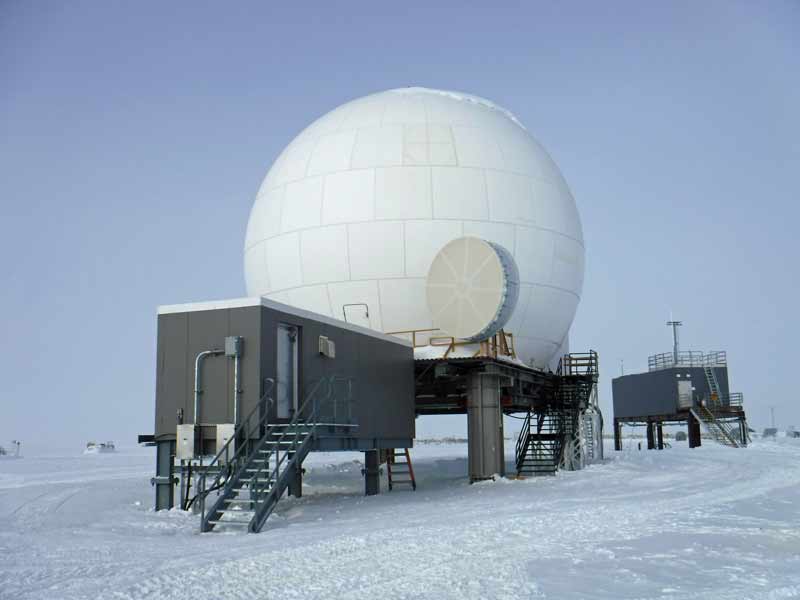
And there it is, the new DSCS shelter, structurally completed at the end of January, although there is still a bunch of satcom wizardry that still needs to happen, as you will see below. At left in the two left photos below is the SPTR-2 radome and control shelter which was completed in 2008-09 to handle the TDRSS satellites (information and acronym definitions). (SH). The shelter is on the downwind (southwest) side of the 9-meter antenna. The radome currently houses small antennas for the DSCS-3 B7 and Skynet-4C satellites (USAP information about the Skynet satellites). After the 9-meter dish is operational for DSCS, the 2.4-meter VSAT antenna inside the radome (February 2017 photo) (MR) will be reconfigured to serve as a backup DSCS antenna as well as the primary Skynet antenna.
Below, a few more photos:
|
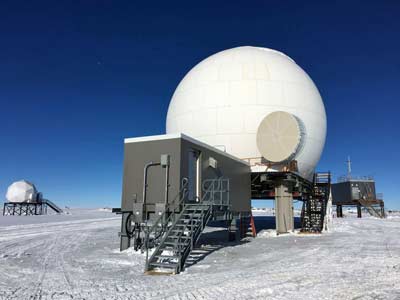 Here's another view--a smaller photo taken on a sunny day (MR). |
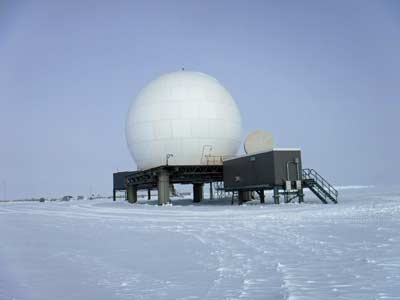 The back side of the DSCS shelter (SH). |
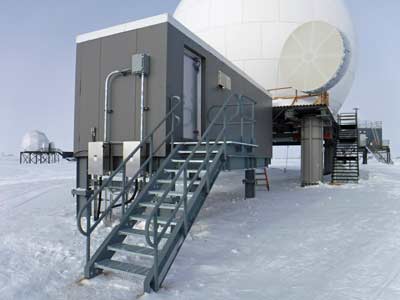 A closer look at the shelter. Astute South Pole veterans will notice something interesting about the door (SH). |
 A view of the interior at the end of the summer construction season (SH). |
|
As suspected, the structure was created from a shipping container with a somewhat prefinished interior. It was delivered nearly empty by one of the South Pole traverses. The exterior foam panels, siding, and trim were installed on site. While the interior was mostly finished when the shelter was delivered, none of the electronic equipment had been preinstalled.
|
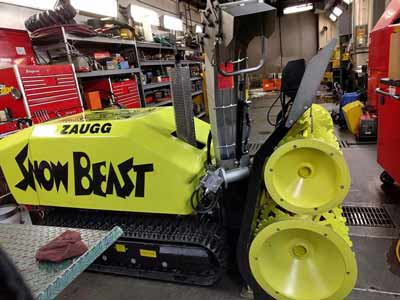 Heading back to the station VMF, we have a ...snow blower. But not an ordinary one. The "Snow Beast" has been equipped with a tethered control module that allows it to clear snow cornices from the downwind end of the arches without risking the operator (SS). |
 A look at the Snow Beast at work as seen from a hallway window. This was from late January. It was also deemed necessary to use the snow blower across the length of the arches, as they were getting heavily buried and there were fears that they might start to collapse. For the last few years it hasn't been permitted to run a dozer on top of the arches (SS). A look at the Snow Beast at work as seen from a hallway window. This was from late January. It was also deemed necessary to use the snow blower across the length of the arches, as they were getting heavily buried and there were fears that they might start to collapse. For the last few years it hasn't been permitted to run a dozer on top of the arches (SS). |
 An action shot, blowing snow off of the downwind end of the arches. Those rectangular items on top of the arches are the snow cornice deflectors...which didn't work. Hence the snow blower (CH). |
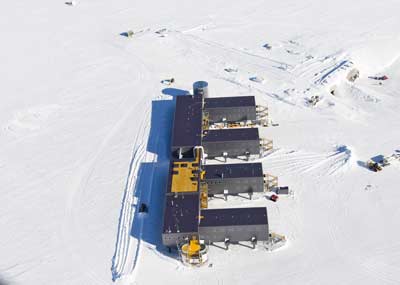 One of the January aerial photos showing the results of some of the snow clearing, mostly on the LO arch and the downwind end (more are here) (JW). |
 Another example of snow clearing method that has been used for many years--pile it all up in a steep hill, and then move the hill further downwind. This is looking from the A1 back staircase in early December (SH). |
 And several weeks later...the pile is gone. Perhaps it was dozed further downwind, or perhaps (the newer option) it was loaded into the snow hauler and...hauled away (SH). |
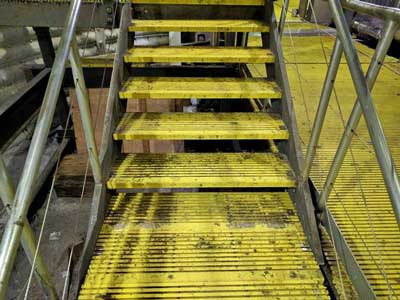 At left, an "after" photo (SS) of a project that wasn't very photogenic--lowering the stair tower structure in the vertical tower (aka "beer can"). This occurred around the Christmas and New Years holidays, and of course these stairs were inaccessible while the work was going on. This was done because the elevated station is settling faster than the vertical tower...and as this continues, eventually the doors from the station onto the upper stair landings would bind up on the sloping ramps (see this 2012 photo of the first floor doors/ramp) (EG). There are ten columns supporting the stair tower structure (which of course also supports the elevator as well as the piping and electrical conduits between the underground arches and the elevated station. Each of the columns had a screw jack fitted to the bottom, and the structure was lowered about 13 inches over a 2 day period. There were also adjustments and modifications required to the piping and conduits. Fortunately, this lowering of the stair tower had been planned for as part of the original design.
At left, an "after" photo (SS) of a project that wasn't very photogenic--lowering the stair tower structure in the vertical tower (aka "beer can"). This occurred around the Christmas and New Years holidays, and of course these stairs were inaccessible while the work was going on. This was done because the elevated station is settling faster than the vertical tower...and as this continues, eventually the doors from the station onto the upper stair landings would bind up on the sloping ramps (see this 2012 photo of the first floor doors/ramp) (EG). There are ten columns supporting the stair tower structure (which of course also supports the elevator as well as the piping and electrical conduits between the underground arches and the elevated station. Each of the columns had a screw jack fitted to the bottom, and the structure was lowered about 13 inches over a 2 day period. There were also adjustments and modifications required to the piping and conduits. Fortunately, this lowering of the stair tower had been planned for as part of the original design.
At some point after I was last at Pole in 2008, someone decided to number the stair steps from 1 to 92...as you can see at left, the first step is #3, so there are now only 90 steps to take your breath away.
Photo credits and thanks: SH is Sayer Houseal; JO is Joseph Orton; KS is Kevin Schriner; MR is Mike Rice; SS is Sheryl Seagraves; CH is Chris Hawkins; JW is Jeff Warneck; and EG is Ethan Good.
Next up: the ice tunnel projects!
|

 A look at the Snow Beast at work as seen from a hallway window. This was from late January. It was also deemed necessary to use the snow blower across the length of the arches, as they were getting heavily buried and there were fears that they might start to collapse. For the last few years it hasn't been permitted to run a dozer on top of the arches (SS).
A look at the Snow Beast at work as seen from a hallway window. This was from late January. It was also deemed necessary to use the snow blower across the length of the arches, as they were getting heavily buried and there were fears that they might start to collapse. For the last few years it hasn't been permitted to run a dozer on top of the arches (SS).










